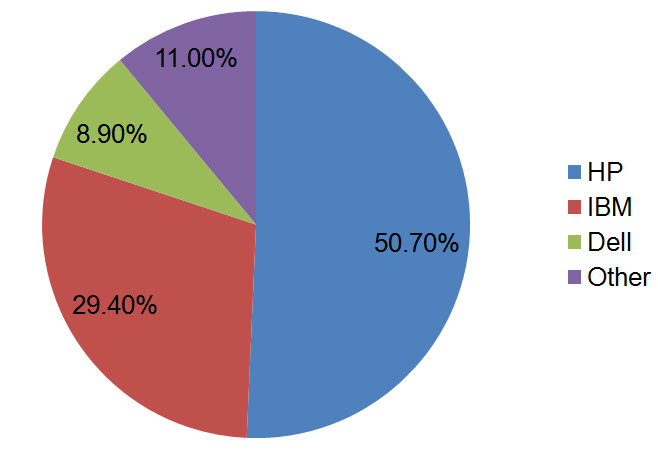IBM announced last week they will be launching a new blade server modeled with the upcoming 4 socket Intel Nehalem EX. While details have not yet been provided on this new server, I wanted to provide an estimation of what this server could look like, based on previous IBM models. I’ve drawn up what I think it will look like below, but first let me describe it.
“New Server Name”
IBM’s naming schema is pretty straight forward: Intel blades are “HS”, AMD blades are “LS”, Power blades are “JS”. Knowing this, I the new server will most likely be called a “HS42“. IBM previously had an HS40 and HS41, so calling it an HS42 would make the most sense.
“Size”
With the amount of memory that each CPU will have access to, I don’t see any way for IBM to create a 4 socket blade that wasn’t a “double-wide” form factor. A “double-wide” design means the server is 2 server slots wide, so in a single IBM BladeCenter H chassis, customers would be limited to 7 x HS42’s per chassis.
“Memory”
The Intel Nehalem EX will tentatively support 16 memory slots PER CPU, across 4 memory channels, so a 4 socket server will have 64 memory slots. Each memory channel can hold up to 4 DIMMs each. This is great, but this is the MAX for an upcoming Intel Nehalem EX server. I do not expect for any blade server vendor to achieve 64 memory slots with 4 CPUs. Since this is the maximum, it makes sense that vendors, like IBM, will be able to use less memory. I expect for these new servers to have 12 memory slots per CPUs (or 3 DIMMs per memory channel). This will still provide 48 memory dimms per” HS42″ blade server; and with 16Gb DIMMs, that would equal 768Gb per blade server.
“CPU”
The “HS42” would have up to 4 x Intel Nehalem EX CPU’s, each with 8 cores, for a total of 32 CPU cores per “HS42” server. HOWEVER, Intel is offering Hyperthreading with this CPU so an 8 core CPU now looks like 16 CPUs.
“Internal Drive Capacity”
I don’t see any way for IBM to have hot-swap drives in this server. There is just not enough real estate. So, I believe they would consider putting in Solid State drives (SSD’s) toward the front of the server. Will they put it on both sides of the server, probably not. The role of these drives would be just to provide space for your boot O/S. The data will sit on a storage area network.
“I/O Expansion”
I don’t think that IBM will re-design their existing I/O architecture for the blade servers. Therefore, I expect for each side of the double-wide “HS42” to have a single CIOv and a CFF-h daughter card expansion slot, so a single HS42 would have 4 expansion slots. This is assuming that IBM designs connector pins that interconnect the two halves of the server together that don’t interfere with the card slots (presumably at the upper half of the connections.)
As we come closer to the release date of the Intel Nehalem EX processor later in Q4 of 2009, I expect to hear more definitive details on the announced 4 socket IBM Blade server, so make sure to check back here later this year.
UPDATE (10/6/09): I’m hearing rumors that IBM’s Nehalem EX processor offerings (aka “X5″ offerings” will be shipping in Q2 of 2010.) Once that is confirmed by IBM, I’ll post a new post.












